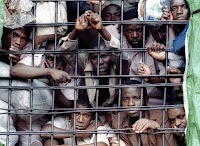By Rwanda News Agency
Monday, 12 April 2010
In this March 10, 2010 photo, Gitarama prison in southern Rwanda, is one of the 14 prison facilities dotted across the country. (Photo: Akorra.com).
Kigali: Rwanda’s rate of incarceration is second only to that of the United States and Russia, according to the International Centre for Prison Studies (ICPS) at King’s College London. In the EAC region, Burundi has the least number of prisoners.
Rwanda has the third highest per capita imprisonment rate in the world, ICPS says in the World Prison Population 2009 report. The United States tops the list, followed up closely by Russia.
The report includes a brief with a summary chart showing that Rwanda’s 14 prison facilities hold 59,311 people – which means that 593 per 100,000 people in Rwanda’s population are behind bars.
From this prison population, about 37,000 are “awaiting trial or serving sentences for crimes associated with the [1994 Tutsi] Genocide.”
However, the British college says that the number of people incarcerated has been dropping over the years. For example, in 1998, the country had some 145,021 prisoners – but this had dropped to 82,000 in 2006.
The drop in jail numbers has been a result of the 2007 law reviewing the categorization of Genocide suspects into three blocks. There was the “first category” of the planners of the mass slaughter and the orchestrators of the rapes – who are judged by the conventional courts. The other two categories were handled by the traditional Gacaca courts.
The changes meant that the number of suspects who were previously classified in the category of planners, were placed in the second category, which would fall as a result under the jurisdiction of the Gacacas which can pronounce a maximum punishment of 30 years of prison, of which the first half would be spent in detention and the other spent working in the public interest. The law also introduced introduced probation, which the Government explained, aimed to reduce the number of prisoners.
The promulgation of law occurred immediately after the release of some 9,000 prisoners, almost all accused of Genocide, on presidential decree.
In global terms, the United States’ prison total constitutes a rate of 756 per 100,000 of the national population, making it by far the biggest user of prison in the world. Russia, for its part, has a 609 rate.
The global report published in February says more than 9.8 million people are held in penal institutions throughout the world. This is an increase of 300,000 since the previous edition two years ago. If prisoners in ‘administrative detention’ in China are included the total is over 10.6 million, says the report.
On a regional basis, Burundi has some 10,700 of its people in jail – translating into some 129 of every 100,000 Burundians. Kenya also has a relatively high number of its nationals behind bars – some 177 in every 100,000 – with 46,662 prisoners.
Uganda (29,826 prisoners – meaning about 91 of 100,000) is the lowest in the EAC region, then Tanzania (40,111 prisoners – 92 of every 100,000).
According to the Rwanda Ministry of Justice, in 2003, more than 20,000 prisoners, principally Genocide suspects, had been freed, followed by nearly 30,000 in 2005. Government argues that depositions have been taken so that these released do not become the cause of insecurity.
Related Materials:
Rwanda's overcrowded prisons and ideological crimes
World Prison Population List (8th edition)

No comments:
Post a Comment